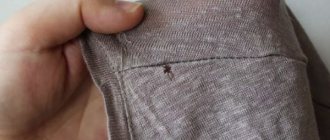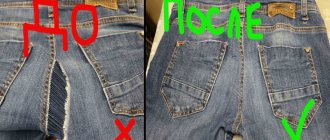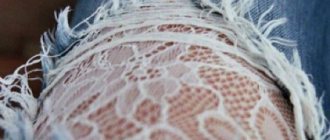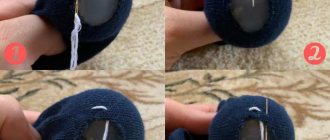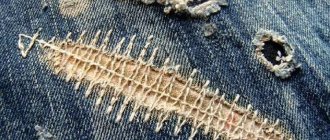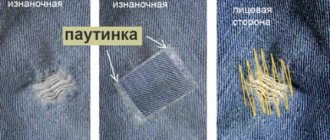Hole on hand knitwear
To repair hand-knitted knitted items, it is recommended to use a special knitted stitch. It is best to take the remnants of the threads from which it was knitted. If the tear is not the result of prolonged wear or a strong snag, it can be closed without anyone noticing.
To work, you need to prepare a hook and a needle with knitted thread.
The procedure is as follows:
- Pick up all missed stitches.
- Take a needle and thread and gather them in pairs, as if the fabric had not been torn.
- Bring the needle to the wrong side, make a few securing stitches, and cut off.
Large holes are closed with a needle step forward. It is made around the incision. This will allow the fabric not to tighten when sewing, and the basting itself will be pulled out during the work area.
To compensate for the volume, transverse threads are passed between the outer loops of the row. They create the basis for darning. When darning, loops are passed through each warp thread from the top to the end of the break. Then the hole is closed from bottom to top.
Some useful tips
It is worth listening to the advice of experienced housewives:
- Be sure to turn the item inside out when you plan to sew it up. The front side of the item must be made perfectly, with invisible seams and knots.
- A seam ripper will be a great help when removing unnecessary stitches.
- Store needles correctly. They should be stuck into a pad or paper.
- Try to work on your own mistakes, because the first attempt may not always be successful.
- The thread should always be matched.
- Be sure to finish the work with the correct stitches, because if you leave the thread and do not fix it in any way at the end, the seam will simply fall apart.
If you are very worried and afraid to sew up the item yourself, then it is better to contact a tailor shop that will readily solve all problems with torn clothing.
Sooner or later, there is a need for knowledge on how to mend a hole in a fabric without being noticed. There are many different techniques that are applicable to fabrics of a certain type, texture and texture.
Hole on genuine leather
Leather is a durable fabric, but it can also be torn. Small holes can be glued from under the bottom with elastic material. Manually suturing such incisions is difficult and the seam will be too rough.
If you need to sew up leather, it is better to do it on a machine with a special foot. For such work they make beautiful decorative patches.
To do this, take 2 blanks:
- made of fabric, shaped slightly larger than the diameter of the tear. It is placed on the inside as a securing lining;
- leather, matching the size of the hole.
They need to be ground down carefully, without moving them relative to the product.
What it is
Glue webs are strings of glue. Bonding of fabric surfaces occurs by heating the fabric, as a result of which the glue threads, melting, penetrate into the structure of the fabric and glue it together. They act as secret machines, which are designed for hidden fastening of fabric, but only the adhesive option is cheaper, since it does not require additional equipment.
Cobweb for fabric is produced in rolls. One such roll is enough for long-term use at home.
Hole in nylon tights
Thin material often tears or gets snagged. If there is no seal, then the product will tear on the toe and between the legs after the first wear. You have to throw it away or disguise it with long clothes. However, it is not always possible to purchase new tights, and you just have to sew them up yourself.
To do this you need:
- Take a thin needle and thread that matches the color of the product.
- Carefully pull the edges of the tear, trying to pick up all the missing loops.
- Insert the needle sequentially, without skipping any loops, to prevent further rupture.
- For strength, treat the seam with clear nail polish.
When tights have become unusable, the threads from them can be used for sewing other products.
What glue is suitable
Not all adhesives are suitable for working with fabrics. In addition, you need to use them correctly. Several variants:
- When working with rubber-based glue, it must be applied on both sides, which increases the drying time and requires a weight for a tight connection.
- Nitrocellulose compositions are applied unilaterally, the parts are connected immediately, only dense elements are connected under pressure.
- PVA glue connects when applied on both sides; a weight is needed for adhesion.
- Rod silicone glue, which is applied with a special heating gun, since it requires heating, does not flow, and quickly polymerizes.
Examples of adhesives that are available in every store:
- Fabric glue “Secunda” has a transparent consistency of medium viscosity, no odor, no stains after drying, and ensures water resistance of the joint.
- “Liquid thread” - suitable for combining materials, gluing decorations, is transparent, dries quickly, and does not damage the fabric.
- JAVANA - made on a water basis, after drying it forms a transparent connection, does not spoil the fabric, does not leave marks, the clothing remains completely flexible at the place of gluing.
When purchasing adhesive mass, you need to take it into account:
- resistance to heat treatments;
- possibility of frequent washing of the processed product;
- seam elasticity;
- high-quality fastening;
- versatility;
- relatively quick setting, the ability to adjust the product.
Hole on lace and guipure
It is possible to restore a torn piece of lace or guipure, but it requires a lot of work.
It is important not to disturb the structure of the weave and therefore you need to know how best to make stitches. Lace repair begins with leveling the edges of the tear to prevent the mesh from breaking.
If the hole is invisible, then it is better to find a suitable piece of material and sew it from the bottom of the torn item using a thin thread.
You can sew up a hole without a seam if you know the weaving features. The thread is collected into bundles and the weaving pattern is recreated. Instead of bobbins, it is proposed to use spools on which you can throw yarn.
Hole in jeans and pants
Thick fabric like denim can fray and tear. It is best to sew it up using the method of simulating thread weaving.
Tissue damage can occur in different places:
- on the knees;
- between the legs;
- in the pocket area;
- at the back point.
On your pocket
The pocket is a visible place, so it is necessary to sew up holes in it using creative ingenuity. It is best to choose an appropriately sized and interesting applique or do embroidery in a given place. The choice of method depends on the size of the tear and the level of fraying of its edges and where the hole is located.
Often holes appear in awkward places under or next to pockets. It can be inconvenient to sew them up or make a patch. Darning, patching or machine stitching in such cases looks rough.
Experts recommend using a piece of denim or a large button. It will cover the area that is sewn up.
Between the legs
The appearance of a hole between the legs is a common problem when wearing trousers and jeans. You can mend such places with a matching thread or by putting an inconspicuous patch.
You can do this by machine or by hand. When using the machine, you must carefully clean the edges from uneven threads and set the straight stitch mode. To make the seam less noticeable, it needs to be steamed after the operation.
If it is decided to install a patch, the material for it is selected that is most suitable in structure and color.
The actions will be as follows:
- Find the fabric and cut the patch to the desired size.
- Turn the product so that you can fully see the gap.
- Overcast the patch fabric with an overlog or a special machine function.
- Turn the product inside out and baste the patch face down.
- Sew along the edge and turn the pants right side out.
Along the seam
If the tear occurs along the seam of the jeans, then sewing it up will not be difficult. True, the material is too dense and difficult to sew by hand, but with the appropriate function of the sewing machine this can be done in a few minutes. The main thing is to clean the tear area from protruding threads and stitch the edges to each other.
The manual method of making a seam is as follows:
- Find a thread according to the color of the trim of the trousers that has a high density. Of course, the new seam will be on the inside and cannot be seen from the outside. But it's better to do everything beautifully.
- Connect the gap and baste with colored thread. You should get a straight line.
- The first stitch of a real seam is made from the inside. This way the knot will be invisible.
- Close the seam with alternating stitches connecting both sides.
- Having reached the end, make several securing stitches from the wrong side.
Behind
If the tear occurs at the back and not along the seam, to hide it, you must use darning or appliqué. This will make your favorite jeans fashionable. Moreover, you can get stylish pants, even if the hole is very frayed.
The procedure is as follows:
- Remove unnecessary threads and attach a suitable applique.
- Glue the reverse side with thin doubler tape.
- Attach the applique and run an iron over it if it is adhesive or sew on a machine if the fabric is heavy.
You can leave everything as is, decorating it with beautiful decor.
On my knee
When jeans are torn at the knee, they can be repaired in 2 ways:
| Way | Description |
| Darn | To do this, I use threads that match the color. The stitches are placed in a dense layer, one on top of the other. At first they go reproach, and then along |
| Leave holes uncovered | To do this, they need to be decorated. If you use an applique, then for work you need to have a thermal tape and a suitable fabric picture |
Basic methods
There are several simple ways to carefully remove the defect of a torn T-shirt. You need to understand each of them in detail.
Invisible darning
If the hole in the T-shirt is small, you can mend it unnoticed. This reliable classic method will allow it not to increase in size.
It is not advisable to use simple threads for this, since the fabric will tighten and the defect will become noticeable to others.
For elastic darning you will need a thin thread from old nylon tights. If it is impossible to match it tone-on-tone with a T-shirt, you can use a neutral option. You need a thin needle, like for bead embroidery.
See also
How to hang a carpet on a wall correctly, step-by-step instructions and best methods
It is necessary to perform several actions in the following sequence:
- Cut unnecessary tights into pieces of a convenient size.
- Carefully pull out the thread and thread it into the needle using a thread threader.
- Without tying a knot, start working from the front side of the T-shirt.
- Slowly, carefully collect all the loops with a needle - take one at a time from below and from above, and then make a small stitch. Be sure to ensure that the fabric does not tighten.
- When the process is complete, bring the needle to the wrong side of the product.
- Sew two or three more stitches to secure the thread well, and then cut it off.
- Flatten the treated area of the fabric of the product and iron it from the inside out. Under the influence of high temperature, the nylon will melt and close the hole even more securely.
Repair using an iron without seams
A small hole can be eliminated without resorting to unnecessary punctures. In this case, you will need a heated iron. The sequence of actions is as follows:
- Lay the T-shirt on a flat, smooth surface.
- From the “gossamer” adhesive tape, specially designed for repairing clothes, cut two pieces of the same size.
- Cut off the corners of the “web” squares.
- Place both pieces together so that the shiny sides are on top.
- In this form, place them inside the T-shirt under the hole.
- Connect the edges of the hole with your fingers.
- Turn on the iron and set the heating temperature to medium.
- Iron the product for thirty seconds.
Using fabric bonding tape
Step-by-step instruction:
- Turn the damaged product inside out.
- Connect the edges of the hole.
- Place fabric gluing tape and interlining on it.
- To prevent anything from moving to the side, place a piece of white cloth on top and spray with a spray bottle.
- Hold the heated iron on the patch for ten seconds.
- Remove the white fabric and turn the product right side out.
How to carefully sew up a large round hole
Large and round holes are more difficult to sew up due to uneven edges and lack of clear contours. In this case, you can use an elastic thread of either the same color or transparent. You can place a special “fungus” for darning or a regular light bulb under the torn area of the product.
See also
TOP 10 remedies for how to clean limescale from a shower head at home
The action plan is:
- Carefully cut off any remaining torn fibers from the edges of the hole.
- Thread a suitable thread into a needle and, moving slowly in a circle, sew each loop with small, neat stitches.
- At the end of the process, it is easy to pull the thread in the center - this will make the area being sewn smaller.
- Fasten the thread from the wrong side and smooth out the T-shirt.
This method is more suitable for products with large patterns or a fleecy surface. On plain products, the sewn fragment may be noticeable.
Hole in the jacket
The fabric on the jacket tears mainly in children, but adults also experience such troubles. There are several ways to fix the defect. It is important to consider the properties of the material from which the jacket is made.
Raincoat fabric or bologna requires special treatment. It needs to be sealed as quickly as possible by placing a patch or adhesive fabric on the inside.
How to sew up a hole at the seam
If a seam on a jacket with insulation has torn, you need to remove it from the edge and sew it up, leaving a gap of 2-3 cm from the edge. It is better to make stitches strictly along the old seam holes.
How to sew up a hole without a seam - a method of darning along the seam of a product
After taking one step, you need to secure it with another stitch. After the row is completely completed, securing stitches are made from the inside, and the assembled seal is evenly distributed over the surface.
How to hide a hole under a zipper
It is difficult to sew up a hole without a seam, but you can hide the tear under a zipper. This will make the clothes original. It is enough to sew a small zipper inside and there will be no trace left of the hole. You can use applique by stitching the fabric on a machine.
Invisible seam on the visible part of the jacket
This seam should be made on the inside of the garment. The needle should be very thin and the thread should match the stitching of the jacket.
The hole is sewn up from the outside by joining the edges. At the end, the thread is slightly pulled and secured.
Fabric patches
There are several types of patches. They can be adhesive, attached from the wrong side, or fabric, sewn from the face. These include various applications, braid, and stripes.
Chevrons
Such decorative details contain inscriptions with the motto, the name of musical groups, clubs.
This allows you to beautifully cover the defect on the jacket and make it stylish.
Braid
This thin strip of fabric is used for decorating holes and repairing clothes. With its help, the seams are strengthened. They come in linen and cotton.
Applications
This is a decorative element for finishing and repairing clothing. Their varieties are wide: rhinestones, buttons and fabric of a certain shape.
Bias tape
It is used to create an edging along the edge of the product. Decorating the hole with it helps make the gap invisible.
Bias tape is used to finish the edges of the product
Edging is done if the edges of the collar, cuffs or pocket are frayed.
Braid or tape
This type of decorative overlay covers the errors of the sleeves, the bottom of the product and the edge of the strap. All straight cuts can be covered with ribbons by stitching along the edges.
Patch pocket
You can sew up a hole almost unnoticeably if you add a patch pocket. The main thing is to make the seam smooth and invisible.
Sewing a hole with a blind stitch
If it is not possible to rip the garment from the inside, experts recommend using a hidden seam.
To do this, the needle is inserted from the inside of the product and the tear is sutured with small parallel stitches. The distance between each of them should be uniform. The thread is secured from the inside.
Where is the web used?
Glue web for fabric is widely used in repairs and making clothing from fabric:
- Connecting parts of the collar and cuffs.
- Processing the bottom of the trousers.
- Connecting the bead and hem instead of shuttle stitching using a blind machine, since the model does not provide for the application of thread seams.
- Elimination of cuts in fabric material.
- Connecting a patch or appliqué to the surface of an item.
- Side seal.
Gossamer tape is not used on everyday clothes, as it is often washed, which adversely affects the quality of gluing, resulting in detachment of the joint.
View this post on Instagram
A post shared by Anya's FABRICS? (@be_be_chic) on Mar 1, 2022 at 8:40pm PST
Hole in a knitted sweater
There are several ways to pick up loose loops. The first is the simplest and allows you to make the rupture site almost invisible after repair. To do this, take threads of the same thickness and shade and a hook. The loops are connected sequentially and at the end the thread is secured from the wrong side.
The second method is simpler and faster: simply crochet the loops and pass them through one another. Here you will have to rely on the drawing, so it is not always possible to use this option.
Features of a hidden seam
The main feature of the current seam is invisibility. Unfortunately, a beginner in this business is not always able to successfully implement stitching without being noticed. The reason for this failure is often a lack of practice.
Is the quality of secrecy so important when sewing up a hole? How else. Every person wants to look neat and make a good impression on people.
But sometimes incidents happen that spoil our appearance. And these are precisely those cases when it is more important than ever to be able to improve the quality of your appearance independently and quickly.
Perhaps one of the main advantages is the budget option. Instead of purchasing a new item, it is enough to learn how to master the hidden seam technique.
Typically, the fabrics initially used are cotton, linen, or wool.
Thanks to the clearly defined figure, the weaving fragments are extremely visible during production. This is what makes it easier for a beginner to gain experience.
How to beautifully sew up a hole in thick fabric
It is quite difficult to repair a tear in thick fabric. To do this, it is better to use patches and glue.
The procedure is as follows:
- Place the patches in place of the hole and secure with a needle or pin.
- Sew or glue the patch, then iron the area.
How to sew up a hole in thick fabric, such as jeans
It is difficult to sew up thick fabric by hand, especially so that it is hardly noticeable from the outside. Therefore, it is better to leave the repair of such products to specialists. Especially if it's an expensive sofa or leather jacket.
You can sew up a hole with or without a seam on different types of fabrics in different ways. Their choice depends on the desire of the performer, the type of fabric and the complexity of the problem.
Preparation
Before you start sewing up a hole in a T-shirt, there are a few important things to consider:
- size of damage;
- degree of fraying of edges;
- type of fabric.
The next step is to determine what types of threads and needles are suitable for the job.
Ideally, use threads of the same color as the torn T-shirt. In some cases, bright threads will look impressive, the shade of which harmonizes or contrasts with the main color of the product. Sometimes it is advisable to use threads pulled from nylon tights or stockings. The thickness of the needle depends on the density of the fabric. Most T-shirts use the finest sewing needles. In addition to threads and needles, you will need an iron and a threader.
